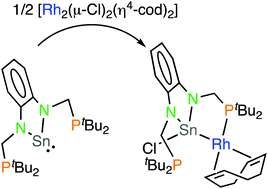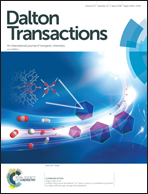Synthesis and some coordination chemistry of the PSnP pincer-type stannylene Sn(NCH2PtBu2)2C6H4, attempts to prepare the PSiP analogue, and the effect of the E atom on the molecular structures of E(NCH2PtBu2)2C6H4 (E = C, Si, Ge, Sn)†
Abstract
The non-donor-stabilized PSnP pincer-type stannylene Sn(NCH2PtBu2)2C6H4 (1) has been prepared by treating SnCl2 with Li2(NCH2PtBu2)2C6H4. All attempts to synthesize the analogous PSiP silylene by reduction of the (previously unknown) silanes SiCl2(NCH2PtBu2)2C6H4 (2), SiHCl(NCH2PtBu2)2C6H4 (3) and SiH(HMDS)(NCH2PtBu2)2C6H4 (4; HMDS = N(SiMe3)2) have been unsuccessful. The almost planar (excluding the tert-butyl groups) molecular structure of stannylene 1 (determined by X-ray crystallography) has been rationalized with the help of DFT calculations, which have shown that, in the series of diphosphanetetrylenes E(NCH2PtBu2)2C6H4 (E = C, Si, Ge, Sn), the most stable conformation of the compounds with E = Ge and Sn has both P atoms very close to the EN2C6H4 plane, near (interacting with) the E atom, whereas for the compounds with E = C and Si, both phosphane groups are located at one side of the EN2C6H4 plane and far away from the E atom. The size of the E atom and the strength of stabilizing donor–acceptor P⋯E interactions (both increase on going down in group 14) are key factors in determining the molecular structures of these diphosphanetetrylenes. The syntheses of the chloridostannyl complexes [Rh{κ2Sn,P-SnCl(NCH2PtBu2)2C6H4}(η4-cod)] (5), [RuCl{κ2Sn,P-SnCl(NCH2PtBu2)2C6H4}(η6-cym)] (6) and [IrCl{κ2Sn,P-SnCl(NCH2PtBu2)2C6H4}(η5-C5Me5)] (7) have demonstrated the tendency of stannylene 1 to insert its Sn atom into M–Cl bonds of transition metal complexes and the preference of the resulting PSnP chloridostannyl group to act as a κ2Sn,P-chelating ligand, maintaining an uncoordinated phosphane fragment. X-ray diffraction data (of 6), 31P{1H} NMR data (of 5–7) and DFT calculations (on 6) are consistent with the existence of a weak P⋯Sn interaction involving the non-coordinated P atom of complexes 5–7, similar to that found in stannylene 1.



 Please wait while we load your content...
Please wait while we load your content...